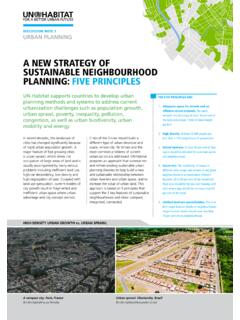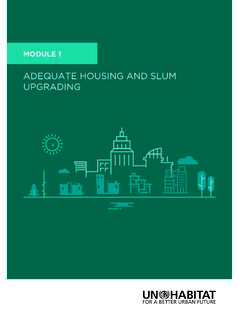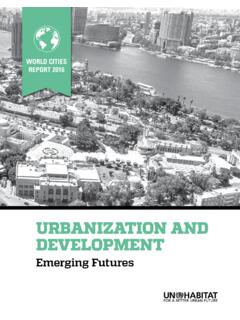Transcription of NEW URBAN AGENDA - UN-Habitat
1 #NewUrbanAgenda #Habitat3 NEWURBANAGENDANEWURBANAGENDAii 2017 United NationsA/RES/71/256*New URBAN AgendaEnglish2017 ISBN: 978-92-1-132731-1 The New URBAN AGENDA was adopted at the United Nations Conference on Housing and sustainable URBAN Development (Habitat III) in Quito, Ecuador, on 20 October 2016. It was endorsed by the United Nations General Assembly at its sixty-eighth plenary meeting of the seventy-first session on 23 December 2016. This publication is not subject to copyright, and it may be freely reproduced provided acknowledgement is given to the United electronic version of this publication, as well as other documents from the Habitat III preparatory process and the Conference itself, are available for download from the Habitat III website at is a United Nations publication issued by the Habitat III Secretariat.
2 Cover: Quito URBAN patternThe printing of this publication was supported by the Government of the Republic of New URBAN AGENDA represents a shared vision for a better and more sustainable future one in which all people have equal rights and access to the benefits and opportunities that cities can offer, and in which the international community reconsiders the URBAN systems and physical form of our URBAN spaces to achieve this. In this unprecedented era of increasing urbanization, and in the context of the 2030 AGENDA for sustainable Development, the Paris Agreement, and other global development agreements and frameworks, we have reached a critical point in understanding that cities can be the source of solutions to, rather than the cause of, the challenges that our world is facing today.
3 If well-planned and well-managed, urbanization can be a powerful tool for sustainable development for both developing and developed countries. The New URBAN AGENDA presents a paradigm shift based on the science of cities; it lays out standards and principles for the planning, construction, development, management, and improvement of URBAN areas along its five main pillars of implementation: national URBAN policies, URBAN legislation and regulations, URBAN planning and design, local economy and municipal finance, and local implementation. It is a resource for every level of government, from national to local; for civil society organizations; the private sector; constituent groups; and for all who call the URBAN spaces of the world home to realize this New URBAN AGENDA incorporates a new recognition of the correlation between good urbanization and development.
4 It underlines the linkages between good urbanization and job creation, livelihood opportunities, and improved quality of life, which should be included in every URBAN renewal policy and strategy. This further highlights the connection between the New URBAN AGENDA and the 2030 AGENDA for sustainable Development, especially Goal 11 on sustainable cities and States; intergovernmental organizations; the United Nations Human Settlements Programme ( UN-Habitat ) plus more than 40 United Nations agencies, funds, and programmes; 200 Policy Unit experts with 20 co-leading organizations; 16 partner constituent groups of the General Assembly of Partners; thousands of subnational and local governments and all major networks of local and regional governments coordinated by the Global Taskforce of Local and Regional Governments; 197 participating states; over 1,100 organizations; and more than 58,000 networks were involved in the preparations of the New URBAN AGENDA .
5 These expert and stakeholder inputs formed the foundation of the zero draft of this document and further feedback was exchanged with Member States during the informal hearings with local governments and stakeholders, and taken into account throughout the intergovernmental negotiations that took place prior to the Conference, where the New URBAN AGENDA was adopted without participatory approach extended into the very framework of the Habitat III Conference in Quito, Ecuador, which is now widely considered to be among the most inclusive and innovative United Nations conferences. Side by side with the intergovernmental plenary sessions and high-level roundtables were the assemblies, which opened and framed the Conference by giving a space to constituent groups, as did the stakeholders roundtables, special sessions, dialogues, and other events organized by various organizations and partners throughout the Conference.
6 It further maximized this participation and focused on implementation of the principles, policies, and actions for sustainable URBAN development by including vthe One UN Pavilion to showcase and enable collaboration among the United Nations agencies, the Habitat III Exhibition to highlight independent organizations' innovations, and the Habitat III Village to exemplify URBAN solutions through actual interventions at the neighborhood level. The Habitat III Conference and the city of Quito welcomed 30,000 participants from 167 countries, with online platforms and tools that enabled people all over the world to follow principal events witnessed a historic realization of the principle of inclusivity, including gender and regional balance considerations on all panels; the meaningful inclusion of slum dwellers and grassroots leaders; the groundbreaking second World Assembly of Local and Regional Governments, as well as the involvement of a wide range of stakeholder groups, which all have a critical role to play in the implementation of this shared vision.
7 It has been my great honor to be the Secretary-General of the Conference. I wish to extend my sincere thanks and congratulations to the Republic of Ecuador for its hospitality and efforts as the host country of the Habitat III Conference. I also extend my gratitude to the members of the Bureau of the Preparatory Committee who guided the entire process, the Co-facilitators of the informal intergovernmental negotiations of the New URBAN AGENDA , and the official delegations involved in these negotiations, as well as the governments and cities that hosted the Habitat III Regional and Thematic Meetings and sessions of the Preparatory Committee, in addition to the members and co-leaders of the Policy Units, the United Nations Task Team on Habitat III, the General Assembly of Partners, the Global Taskforce for Local and Regional Governments, and other organizations that observed the negotiations and contributed to subsequent drafts of the New URBAN AGENDA .
8 I also extend my thanks to all staff who worked tirelessly to ensure that the expertise and voices of many thousands of contributors around the world were amplified and carried into these pages. There is no single prescription for improving urbanization and achieving sustainable URBAN development, but the New URBAN AGENDA provides the principles and tested practices to bring its vision to life, off of these pages and into reality. May it inspire and inform the decision-makers and URBAN inhabitants of the world to take ownership of our shared URBAN future: one policy, law, plan, design, or project at a time. At this critical juncture in human history, rethinking the way we plan, build, and manage our URBAN spaces is not an option but an imperative. Our work to realize this vision begins Joan ClosSecretary-General of the United Nations Conference on Housing and sustainable URBAN Development (Habitat III) URBAN AgendaQuito Declaration on sustainable Cities and Human Settlements for AllQuito Implementation Plan for the New URBAN AgendaAcknowledgementsHabitat III RoadmapCONTENTS viii1 NEW URBAN AGENDA2 QUITO DECLARATION O N sustainable CITIES AND HUMAN SETTLEMENTS FOR ALLNew URBAN Agenda31.
9 We, Heads of State and Government, Ministers and High Representatives, have gathered at the United Nations Conference on Housing and sustainable URBAN Development (Habitat III) from 17 to 20 October 2016 in Quito, with the participation of subnational and local governments, parliamentarians, civil society, indigenous peoples and local communities, the private sector, professionals and practitioners, the scientific and academic community, and other relevant stakeholders, to adopt a New URBAN By 2050, the world s URBAN population is expected to nearly double, making urbanization one of the twenty-first century s most transformative trends. Populations, economic activities, social and cultural interactions, as well as environmental and humanitarian impacts, are increasingly concentrated in cities, and this poses massive sustainability challenges in terms of housing, infrastructure, basic services, food security, health, education, decent jobs, safety and natural resources, among others.
10 3. Since the United Nations Conferences on Human Settlements in Vancouver, Canada, in 1976 and in Istanbul, Turkey, in 1996, and the adoption of the Millennium Development Goals in 2000, we have seen improvements in the quality of life of millions of URBAN inhabitants, including slum and informal-settlement dwellers. However, the persistence of multiple forms of poverty, growing inequalities and environmental degradation remain among the major obstacles to sustainable development worldwide, with social and economic exclusion and spatial segregation often an irrefutable reality in cities and human settlements. 4. We are still far from adequately addressing these and other existing and emerging challenges, and there is a need to take advantage of the opportunities presented by urbanization as an engine of sustained and inclusive economic growth, social and cultural development, and environmental protection, and of its potential contributions to the achievement of transformative and sustainable development.










